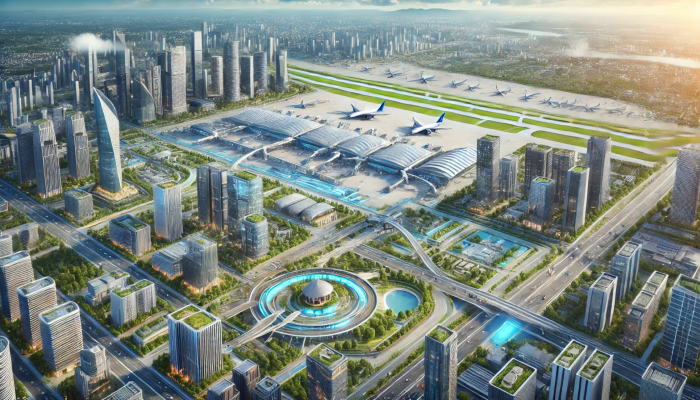Why Nigeria Needs Aerotropolis to Unlock Airport-Led Urban Growth

Nigeria’s Missed Aerotropolis Opportunity: Aviation Expert Faults Policy Instability, Poor Planning
Despite Nigeria’s push to become a leading aviation hub in Africa, it has failed to develop aerotropolis ecosystems around its major airports—a missed opportunity that continues to stifle urban integration, investment inflows, and job creation, according to aviation security consultant and retired Group Captain John Ojikutu.
In a wide-ranging interview with the News Agency of Nigeria (NAN), Ojikutu highlighted the urgent need to revisit Nigeria’s dormant plans for aerotropolis development—airport-driven urban zones that integrate residential, commercial, and logistics activities within the airport vicinity.
“Aerotropolis has been on the books of FAAN (Federal Airports Authority of Nigeria) for over 20 years, but unstable government policies and administrative self-interest have blocked implementation,” he said.
What Is an Aerotropolis?
An aerotropolis is a metropolitan sub-region where the layout, infrastructure, and economy are centered on an airport. Think of it as a mini-city built around aviation and trade logistics, often including:
- Business parks and logistics hubs
- Hotels, shopping centers, and recreational spaces
- Housing estates and multi-modal transport links
- Aviation-related industries (e.g., maintenance, cargo, ground handling)
Globally, cities like Amsterdam, Dubai, Atlanta, and Incheon have adopted the aerotropolis model to drive sustainable economic growth, attract foreign direct investment (FDI), and boost non-aeronautical revenue streams for airports.
The Nigerian Reality: Encroachment, Poor Land Use, Policy Paralysis
Citing the case of Murtala Muhammed Airport (MMA) in Lagos, Nigeria’s busiest aviation hub, Ojikutu decried the distorted master plan, which originally envisioned four passenger terminals, but now hosts only two, both heavily congested and overlapping with private and military aviation operations.
“The entire MMA infrastructure—domestic and international terminals, airline offices, fuel depots, ground handlers, even military barracks—are all crammed into one side of the airport,” he said.
“The other side, which should have supported expansion or aerotropolis development, has been encroached upon by public housing and private developers.”
He noted that unauthorized land allocations have robbed the airport of valuable real estate that could have been used for hotels, malls, parks, and aviation logistics, which are the core components of an aerotropolis ecosystem.
Policy Inconsistency and Abandoned Reforms
Ojikutu further blamed the collapse of Nigeria’s aerotropolis vision on policy inconsistency and lack of political will.
“Since the successful concession of MMA2 under the Privatisation, Commercialisation and Concession Act of 2000, no other major infrastructure project has followed suit. The Act has essentially been abandoned,” he lamented.
Despite years of rhetoric around airport commercialisation, Nigeria has been slow to implement public-private partnerships (PPP), modern concession models, or integrated land use planning in its airport zones.
Security Concerns: Too Many Agencies, No Unified Command
On the security front, Ojikutu criticized the fragmented security architecture at Nigerian airports, which he says further complicates the airport-city integration vision.
“More than six different government agencies operate within our airports, but with no unified command-and-control structure. This leads to turf wars and weak oversight,” he warned.
He called for a consolidated aviation security framework with clearly defined leadership to manage threats efficiently and foster investor confidence.
BRANDECONOMY Insight: Aerotropolis Is More Than Urban Planning—It’s Economic Strategy
For Nigeria, the aerotropolis concept is not just an urban design novelty—it represents a game-changing economic strategy. With airports becoming economic anchors rather than transit points, building cities around airports can unlock:
- Increased non-aeronautical revenue (retail, hospitality, logistics)
- Job creation across construction, transport, and services
- Improved infrastructure funding through PPPs
- Boost to exports and e-commerce via integrated cargo hubs
- Stronger regional competitiveness in aviation and trade
Countries like Ethiopia, Ghana, Rwanda, and South Africa are already embracing this model. For Nigeria to reclaim its place as Africa’s aviation giant, it must fast-track master plan implementation, reclaim airport-adjacent lands, and adopt consistent aviation development policies.










